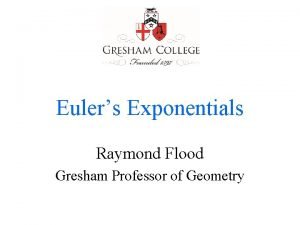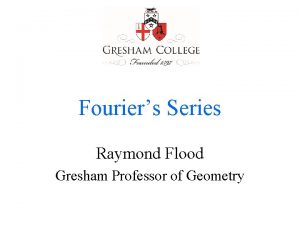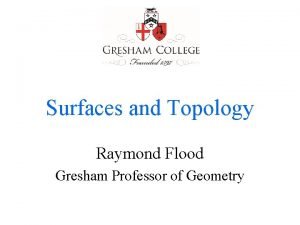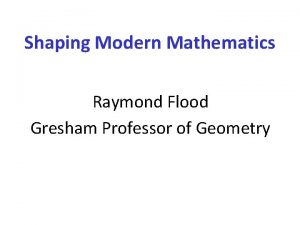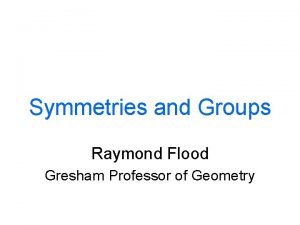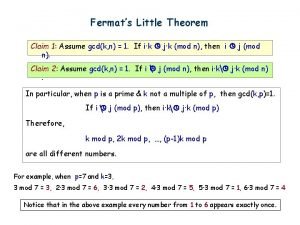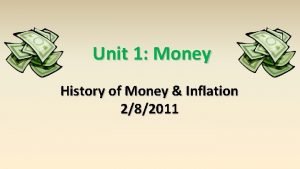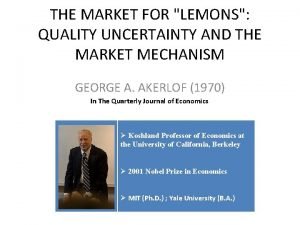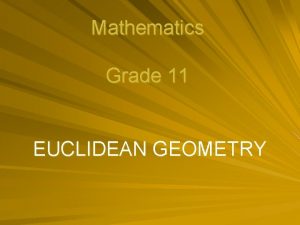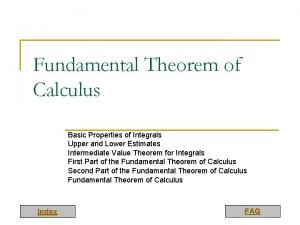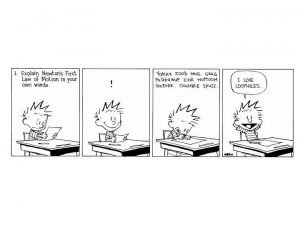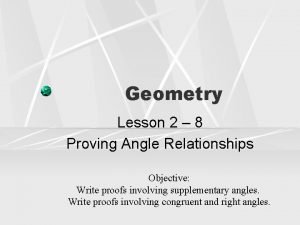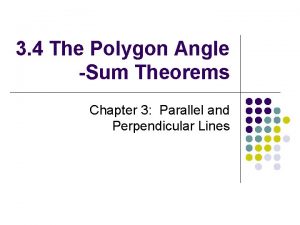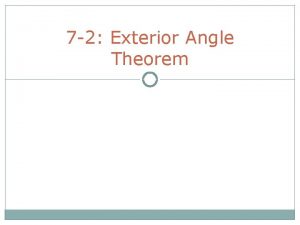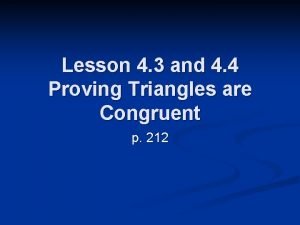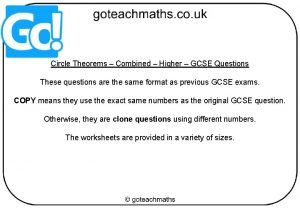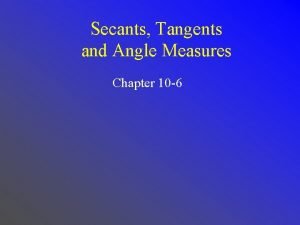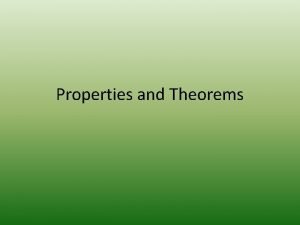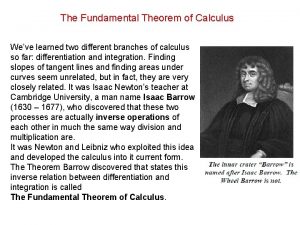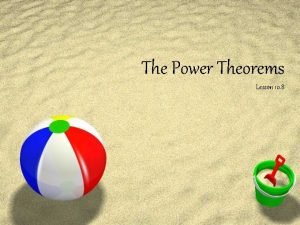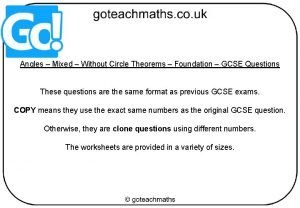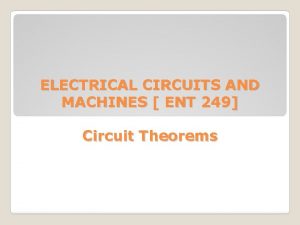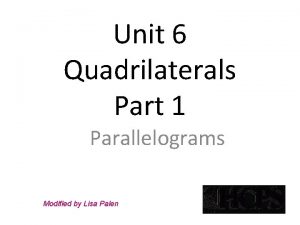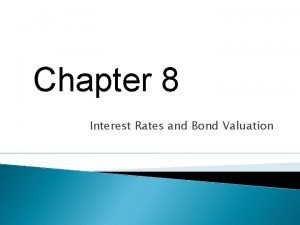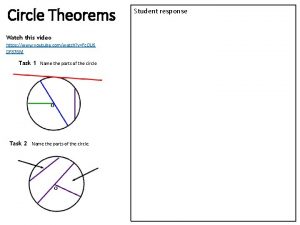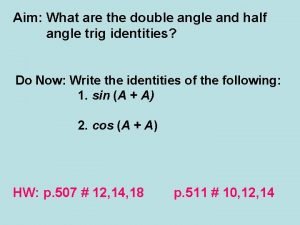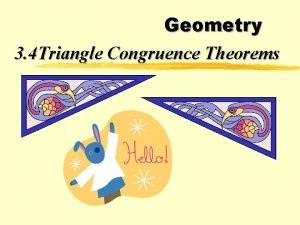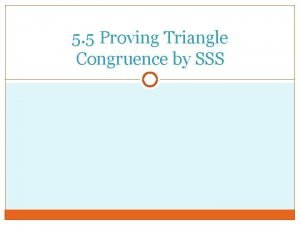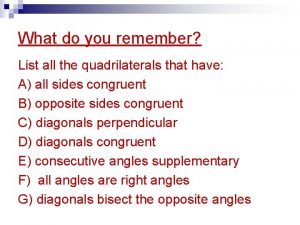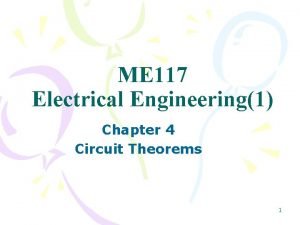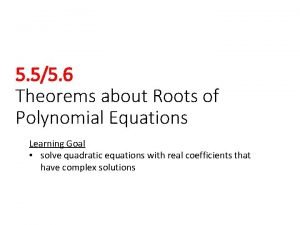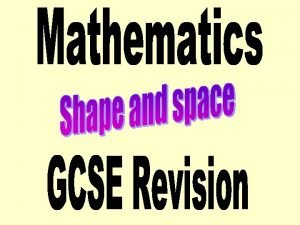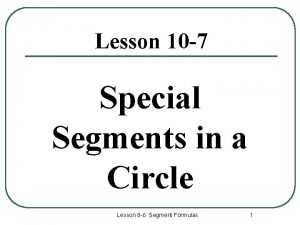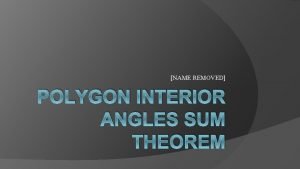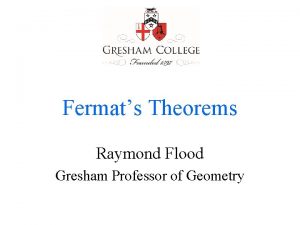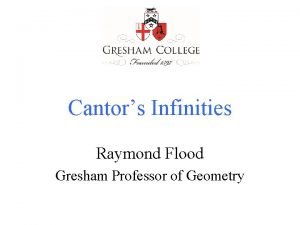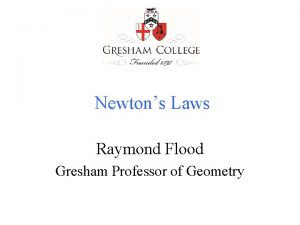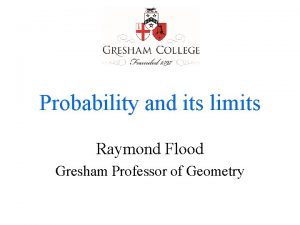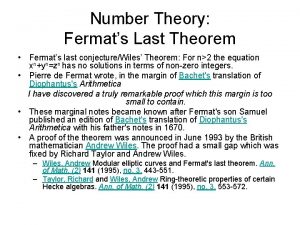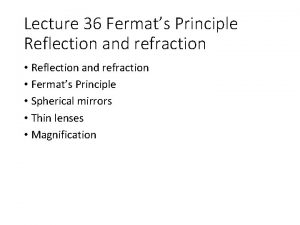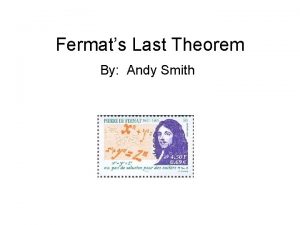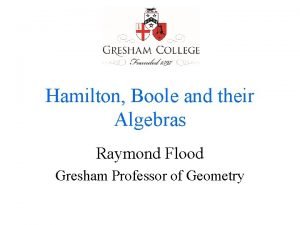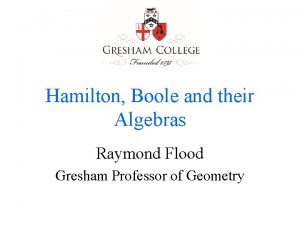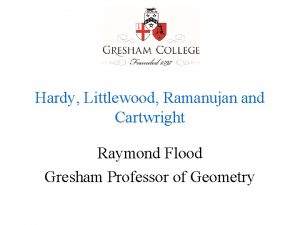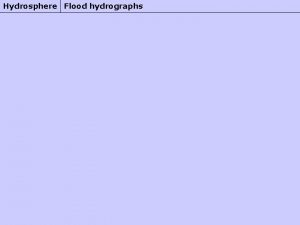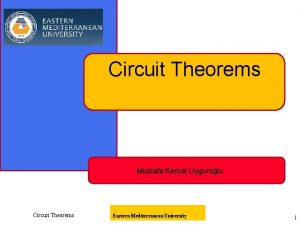Fermats Theorems Raymond Flood Gresham Professor of Geometry









































- Slides: 41

Fermat’s Theorems Raymond Flood Gresham Professor of Geometry

Newton’s Laws Tuesday 21 October 2014 Euler’s Exponentials Tuesday 18 November 2014

Fourier’s Series Tuesday 20 January 2015 Möbius and his band Tuesday 17 February 2015

Cantor’s Infinities Tuesday 17 March 2015

Pierre de Fermat 160? - 1665 • Fermat and Descartes founders of analytic geometry • Fermat principle of least time • Fermat and Pascal laid the foundations of modern probability theory • Number theory

Founders of Analytic Geometry Pierre de Fermat (160? – 1665) René Descartes(1596– 1650) Analytic geometry – using algebra and a system of axes along which lengths are measured to solve geometric questions

Fermat’s Principle: “nature operates by the simplest and expeditious ways and means” Refraction of light A ray of light goes from Q 1 in air to Q 2 in water touching the boundary between the air and water at the point R. From Fermat’s Principle of Least Time we want R to be chosen to make the total time of travel as small as possible. Q 1 R/v 1 + RQ 2/v 2 Minimised when the angle of incidence and the angle of refraction are related by sin / sin = v 1/v 2

Founders of Modern Probability Pierre de Fermat (160? – 1665) Blaise Pascal (1623– 1662)

A gambling problem: the interrupted game What is the fair division of stakes in a game which is interrupted before its conclusion? Example: suppose that two players agree to play a certain game repeatedly to win £ 64; the winner is the one who first wins four times. If the game is interrupted when one player has won two games and the other player has won one game, how should the £ 64 be divided fairly between the players?

Interrupted game: Fermat’s approach Original intention: Winner is first to win 4 tosses Interrupted when You have won 2 and I have won 1. Imagine playing another 4 games Outcomes are all equally likely and are (Y = you, M = me): YYYY YYYM YYMY YYMM YMYY YMYM YMMY YMMM MYYY MYYM MYMY MYMM MMYY MMYM MMMY MMMM Probability you would have won is 11/16 Probability I would have won is 5/16

Fermat’s Number Theory • Restricted his work to integers • Primes numbers and divisibility • How to generate families of solutions

Method of Infinite descent "As ordinary methods, such as are found in books, are inadequate to proving such difficult propositions, I discovered at last a most singular method. . . which I called the infinite descent. At first I used it to prove only negative assertions, such as ‘There is no right angled triangle in numbers whose area is a square’. . . To apply it to affirmative questions is much harder, so when I had to prove ‘Every prime of the form 4 n+1 is a sum of two squares’ I found myself in a sorry plight (en belle peine). But at last such questions proved amenable to my methods. " -Quoted from Andre Weil's Number Theory

There is no right angled triangle in numbers (integers) whose area is a square 4 5 13 12 15 17 3 Area = 6 5 Area = 30 8 Area = 60

There is no right angled triangle in numbers (integers) whose area is a square 4 5 13 12 15 17 3 Area = 6 5 Area = 30 Suppose this is a triangle with integer sides and area a square 8 Area = 60

There is no right angled triangle in numbers (integers) whose area is a square 4 5 13 12 17 15 3 Area = 6 5 Area = 30 Suppose this is a triangle with integer sides and area a square Then there are integers x and y so that the hypotenuse is x 2 + y 2 8 Area = 60 x 2 + y 2 x Area a square and hypotenuse length x

Fermat on infinite descent If there was some right triangle of integers that had an area equal to a square there would be another triangle less than it which has the same property. If there were a second less than the first which had the same property there would be by similar reasoning a third less than the second which had the same property and then a fourth, a fifth etc. ad infinitum. But given a number there cannot be infinitely many others in decreasing order less than it – I mean to speak always of integers. From which one concludes that it is therefore impossible that any right triangle

Every prime of the form 4 n+1 is a sum of two squares Let us list all prime numbers of the form 4 n + 1 (that is, each is one more than a multiple of 4): 5, 13, 17, 29, 37, 41, 53, 61, …. Fermat observed that Every prime number in this list can be written as the sum of two squares: for example, 13 = 4 + 9 = 22 + 32 41 = 16 + 25 = 42 + 52.

Fermat primes • Fermat conjectured that if n is a power of 2 then 2 n + 1 is prime. Indeed the first few of these numbers are indeed prime: • • • 21 + 1 = 3 22 + 1 = 5 24 + 1 = 17 28 + 1 = 257 216 + 1 = 65537 But 232 + 1 = 4294967297 = 641 × 6700417

Fermat primes • Fermat conjectured that if n is a power of 2 then 2 n + 1 is prime. Indeed the first few of these numbers are indeed prime: • 21 + 1 = 3 • 22 + 1 = 5 • 24 + 1 = 17 • 28 + 1 = 257 • 216 + 1 = 65537 • But 232 + 1 = 4294967297 = 641 × 6700417 Because 232 + 1 = (232 + 54× 228) – (54× 228 – 1) Now 641 = 24 + 54 and = 5× 27 +1 So 232 + 1 = 228(24 + 54) – (5× 27 + 1) (5× 27 - 1) (52× 214 + 1)

Pell’s equation C x 2 + 1 = y 2 Fermat challenged his mathematical contemporaries to solve it for the case of C = 109 x 2 + 1 = y 2 The smallest solution is x = 15, 140, 424, 455, 100 and y = 158, 070, 671, 986, 249

Modular Arithmetic We define a b mod n and say a is congruent to b mod n whenever a and b have the same remainders when we divide by n. An equivalent way of describing this is that n divides a – b. Examples: 35 11 mod 24, 18 11 mod 7, 16 1 mod 5 If a b mod n and c d mod n Addition: a + c b + d mod n Multiplication: ac bd mod n Cancellation: If ac bc mod p and p is a prime

Fermat’s Little Theorem Pick any prime, p and any integer, k, smaller than p. Raise k to the power of p – 1 and find its remainder on dividing by p. The answer is always 1 no matter what p is or k is! kp – 1 1 mod p Pick your p = 7, k = 5 Then we know that 57 – 1 = 56 leaves a remainder of 1 when divided by 7.

Fermat’s little theorem: Proof p = 7 k = 5 prove 57 – 1 1 mod 7 List A: 1, 2, 3, 4, 5, 6, mod 7 Multiply each by k = 5 List B: 5, 10, 15, 20, 25, 30, mod 7 When we write it mod 7 we obtain list A in a different order. List C: 5, 3, 1, 6, 4, 2, mod 7 So the terms in list A multiplied together are the same mod 7 as the terms in list B multiplied together. 5. 1. 5. 2. 5. 3. 5. 4. 5. 5. 5. 6 1. 2. 3. 4. 5. 6 mod 7 56. 1. 2. 3. 4. 5. 6 mod 7 We cancel 1. 2. 3. 4. 5. 6 as it is not divisible by 7 to get 56 1 mod 7

Primality testing Pick any prime, p and any integer, k, smaller than p. kp – 1 1 mod p So the consequence is that if for any choice of a the remainder is not 1 then the number p is not prime. For example: a = 2 and modulus, p, is 15 214 mod 15 24 x 22 mod 15 16 x 4 mod 15 1 x 1 x 4 mod 15

RSA Algorithm Ronald Rivest, Adi Shamir and Leonard Adleman Publish N and E

Fermat’s marginal note A 1621 French edition of Diophantus’s Arithmetica Fermat’s marginal note published in his son’s edition of Diophantus’s Arithmetica

Fermat’s marginal note Cubum autem in duos cubos, aut quadratoquadratum in duos quadratos, et generaliter nullam in infinitum ultra quadratum potestatem in duos eiusdem nominis fas est dividere cuius rei demonstrationem mirabilem sane detexi. Hanc marginis exiguitas non caperet It is impossible to separate a cube into two cubes, or a fourth power into two fourth powers, or in general, any power higher than the second, into two like powers. I have discovered a truly marvellous proof of this, which this margin is too narrow to contain.

Fermat’s ‘Last Theorem’ The equation xn + yn = zn has no whole number solutions if n is any integer greater than or equal to 3. Only need to prove for n equal to 4 or n an odd prime. Suppose you have proved theorem when n is 4 or an odd prime then it must also be true for every other n for example for n = 200 because x 200 + y 200 = z 200 can be rewritten (x 50)4 + (y 50)4 = (z 50)4 so any solution for n = 200 would give a solution for n = 4 which is not possible.

The case n = 4 Suppose there is a solution in integers to the equation x 4 + y 4 = z 4 This can be written (x 2)2 + (y 2)2 = (z 2)2 We can use it to find another right angled triangle with integer sides whose area is a square BUT Fermat had used his method of infinite descent to show that such a triangle was impossible

First 200 years • Fermat did n = 4 • Euler did n = 3 in 1770 • Legendre and Peter Lejeune-Dirichlet did n = 5 in 1825 • Gabriel Lamé did n = 7 in 1839

Sophie Germain, 1776 - 1831 xn + yn = zn If n is any prime number less than 100, then there are no positive integer solutions if x, y and z are mutually prime to one another and to n. Sophie Germain aged 14

A False Proof, 1847 xn + yn = (x + y)(x + 2 y) (x + n – 1 y) where n = 1 Suppose this equals zn for some z. He concluded that each factor was also an nth power. Then he could derive a contradiction. But the conclusion that each factor was also an nth power was wrong! Unique prime factorization does not always hold!

Ernst Kummer 1810 - 1893 • Ideal numbers • Algebraic number theory • Fermat’s last theorem proved for regular primes


Andrew Wiles lectures on elliptic curves

The Breakthrough Elliptic Curve y 2 = x 3 + rx 2 + sx + t, for some integers r, s and t

The Breakthrough Elliptic Curve Modular form y 2 = x 3 + rx 2 + sx + t, for some integers r, s and t A way of generalizing the Möbius transformations f(z) = (az + b)/(cz + d)

The Breakthrough Elliptic Curve Modular form y 2 = x 3 + rx 2 + sx + t, for some integers r, s and t A way of generalizing the Möbius transformations f(z) = (az + b)/(cz + d) Taniyama – Shimura Conjecture Every elliptic curve is associated with a modular form

Suppose a p + b p = c p Then y 2 = x 3 +(bp - ap) x 2 - apbp x would have such bizarre properties that it could not be modular, thereby contradicting the Taniyama–Shimura conjecture. Wiles set himself the task of proving the special case of the Taniyama–Shimura conjecture that implied the truth of Fermat’s last theorem.

References • Pierre de Fermat, Complete Dictionary of Scientific Biography, Michael S Mahoney http: //www. encyclopedia. com/topic/Pierre_de_Fermat. aspx • Simon Singh, Fermat’s Last theorem, Fourth Estate, 1998 • BBC Horizon Program on Fermat’s Last Theorem is available from the BBC at http: //www. bbc. co. uk/programmes/b 0074 rxx

1 pm on Tuesdays Museum of London Fermat’s Theorems: Tuesday 16 September 2014 Newton’s Laws: Tuesday 21 October 2014 Euler’s Exponentials: Tuesday 18 November 2014 Fourier’s Series: Tuesday 20 January 2015 Möbius and his Band: Tuesday 17 February 2015 Cantor’s Infinities: Tuesday 17 March 2015
 Gresham professor of geometry
Gresham professor of geometry Gresham professor of geometry
Gresham professor of geometry Hexagonal torus
Hexagonal torus Quickest descent
Quickest descent Raymond flood
Raymond flood Fermat's little theorem example
Fermat's little theorem example Gresham’s law
Gresham’s law Gresham’s law
Gresham’s law Grade 11 euclidean geometry revision
Grade 11 euclidean geometry revision Promotion from associate professor to professor
Promotion from associate professor to professor Vsepr model vs lewis structure
Vsepr model vs lewis structure 4 electron domains 2 lone pairs
4 electron domains 2 lone pairs This molecule is
This molecule is Calculus theorems
Calculus theorems Rth
Rth Cyclic coordinates and conservation theorems
Cyclic coordinates and conservation theorems Theorem 2-8
Theorem 2-8 Congruent angles
Congruent angles Dissimilarities between green’s and stokes’ theorems.
Dissimilarities between green’s and stokes’ theorems. The exterior angle theorem answer key
The exterior angle theorem answer key Right triangle congruence theorems
Right triangle congruence theorems Circle theorems gcse questions
Circle theorems gcse questions 9.6 secants tangents and angle measures
9.6 secants tangents and angle measures List of theorem
List of theorem Average rate of change with integrals
Average rate of change with integrals Theorem 97
Theorem 97 Circle theorems gcse questions
Circle theorems gcse questions Electrical theorems
Electrical theorems Triangle congruence review maze answers
Triangle congruence review maze answers M<5
M<5 Bond valuation theorems
Bond valuation theorems Circle theorems geogebra
Circle theorems geogebra Double angle theorems
Double angle theorems Conservation theorem and symmetry properties
Conservation theorem and symmetry properties 4 triangle congruence theorems
4 triangle congruence theorems Hl congruence theorem
Hl congruence theorem Kites and trapezoids quizizz
Kites and trapezoids quizizz Electrical theorems
Electrical theorems 5-5 theorems about roots of polynomial equations
5-5 theorems about roots of polynomial equations Theorems
Theorems 10-7 special segments in a circle
10-7 special segments in a circle Polygon interior angles theorem
Polygon interior angles theorem
